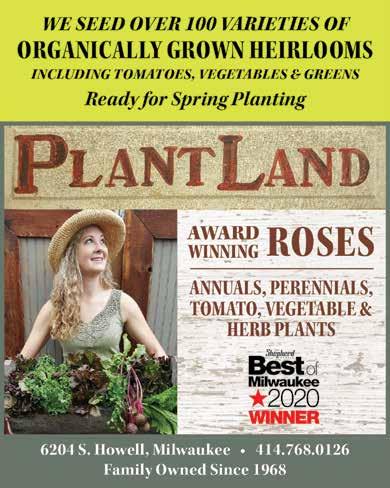
3 minute read
Organic Gardening Made Easy
Organic Gardening
Made Easy
Advertisement
By Mark Hagen
Whether you call it chemical-free gardening, earth-friendly planting or natural farming, it all comes down to the same practice—organic gardening. But what exactly is it?
In a (biodegradable, all-natural) nutshell, organic gardening relies on tools and techniques that do not involve synthetic fertilizers and pesticides. Instead, organic gardeners turn to natural and plant-derived options to improve the quality of the planting soil, fight insects and disease, and strengthen the quality of the plant. An organic garden is a tiny part of nature’s overall system. And today’s gardeners are flocking to the concept. Because they lack the use of pesticides and synthetic additives, organic gardens are kind to the water table and the planet overall. Many organic fans believe that foods grown organically taste better, and while some scientists disagree, there is mounting evidence that organically grown foods are more nutritious. Regardless of scientific fact, many people simply feel better about consuming produce from organic gardens.
Interested in giving organic gardening a shot? You’d be surprised how easy it is, and it all starts with getting your hands dirty.
PREPARE THE SOIL. Because you won’t be gardening with synthetic fertilizers, you’ll want to give your veggies a great start, and that begins with the soil. Work plenty of compost into the soil to add nutrients and keep it moist. In general, treat the soil well, and it will reward you all season long.
Some choose to avoid planting in the ground altogether, using raised beds instead. Not only do these beds allow you to best control the nutrients in the soil, but the soil warms up faster in spring, extends the growing season, and it saves some wear and tear on your knees. Just be sure the wood hasn’t been chemically treated if you’re going for a pure organic garden.
GET PLANTING. Select plants suited to your garden’s conditions. In other words, don’t plant sun-lovers in the shade or water-cravers in sandy soil. When buying seeds and starter plants, you may need to do a bit of research. For instance, many plants are nurtured with chemicals and pesticides before being shipped to garden centers. Consider purchasing plants from a farmers market, where you can ask the seller directly about organic farming practices.
Try to plant a few flowers nearby that attract bees. Pollination is key to healthy plants, so encouraging bees to stop by your garden is a popular hack for today’s organic gardeners. Another trick? Leave enough space between the plants to allow air to circulate. Plants that are too close together can lead to fungus issues, which can be difficult to control without chemicals.
Once your plants are set, toss on a layer of mulch. Adding an inch or two over the topsoil helps retain moisture, suppresses weeds and keeps the soil healthy. Make your own organic mulch with grass clippings, dried leaves, pine needles or portions of your very own compost heap. Depending on the mulch you use, you may have to replenish it throughout the season.
REAP WHAT YOU SOW. Now’s the fun part! Simply maintain your organic garden and enjoy the fruits of your labor. If you do need to buy a fertilizer, plant booster or mulch, be sure to buy organic.
Be wary of labels boasting claims such as “natural” or “nature’s favorite.” While these descriptors sound lovely, they could be marketing ploys. When in doubt, ask a garden center employee or do a bit of online research to find the organic products that are right for you.
Mark Hagen is a décor enthusiast whose home has been featured in numerous national publications. His work has appeared in Fresh Home and Your Family magazines.












